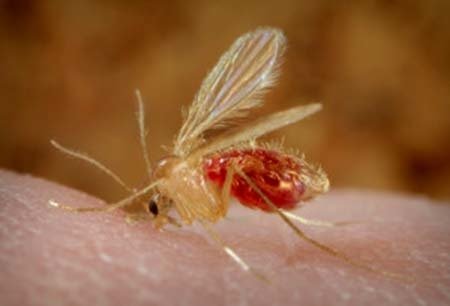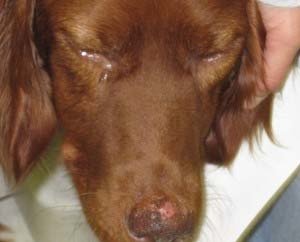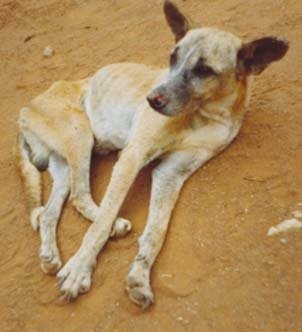Vegan food at Leishmania
This article is a translation of the article Purinarme Ernährung bei Leishmaniosiswritten by Lisa Walther. Lisa is a veterinarian and worked in the companion animal department at the University of Munich. She specializes in dietetics.
Time and again dog owners come to us whose four-legged friend suffers from a chronic disease. They want to know whether Vegdog wet food is suitable for dogs with a certain clinical picture.
This often concerns Leishmania.
But what exactly is it and what considerations do you have to make when feeding? Can a vegan diet have a positive influence?
Leishmania is an infectious disease. The pathogens are protozoa, or single-celled organisms, which are transmitted by sand flies. Other ways of contamination (blood transfusions, through contact with infected dogs) are extremely rare. For a long time, the sand flies only occurred below 45e latitude (the 45e latitude is exactly the center between the equator and the north pole). They infect dogs that come from countries around the Mediterranean or dogs that go on holiday with their owners in this area. Recently, the presence of sand flies has also been observed in the south of Germany. Leishmania infections may also occur in these areas in the future.
SANDFLY (© Frank Collins)
The transmission of pathogens occurs when the female mosquitoes suck the blood. The Leishmania then parasitizes intracellularly, especially in macrophages (cells of the immune system). Interestingly, infected dogs don't necessarily get sick. That is, they have Leishmania, but do not develop symptoms. It is difficult to predict whether and when the disease will develop. There is a correlation between the number of antibodies (number of living blood antibodies formed from the dog's body relative to the pathogens) and the likelihood of symptoms occurring.

These symptoms are often nonspecific at first and appear intermittently. This includes fever, apathy, weight loss and bald patches in the coat. Depending on the course, different appearances are possible. A distinction is made between the skin (including hair loss on the nose, ear tips, "glasses" around the eyes), mucous membranes and internal organs (especially glomerulonephritis → inflammation of the kidneys). All these forms can occur separately or simultaneously. In the dogs where Leishmania actually develops, 90% will die of this if they are not treated.
Ulceration (ulceration) and loss of pigmentation on the nose cap and purulent conjunctivitis (inflamed mucous membrane of the eye) (© Uwe Gille / BY-SA 3.0 / www.creativecommons.org / licenses / by-sa / 3.0 /)


Ulceration (ulceration) and loss of pigmentation on the nose cap and purulent conjunctivitis (inflamed mucous membrane of the eye) (© Uwe Gille / BY-SA 3.0 / www.creativecommons.org / licenses / by-sa / 3.0 /)
What does the treatment look like and what does this have to do with the diet?
First of all: Leishmania cannot be cured in dogs.
With the use of medications, it is possible to relieve symptoms, but the pathogens are most likely to last a lifetime in the dog's body. A new outbreak of the disease is not unlikely, even after successful control of symptoms, and requires new treatment.
A commonly used medicine is “allopurinol”, which is used in humans, among other things, for the treatment of gout. It is absorbed by the Leishmania and eventually inhibits its spread (proliferation). However, it also directly has a different effect on the dog itself. This hinders the enzymatic breakdown of purines to allantoin. Purines are important parts of DNA and RNA and can be synthesized by the dog itself. All purines that enter the body through diet are not necessary for the construction of the genome, but are broken down and excreted by the kidneys. The breakdown to allantoin is inhibited by the leishmania drug “allopurinol”, so that the 'intermediate' xanthine accumulates in large numbers. With the risk of the formation of kidney stones (“Xanthi stones”) as a result. That is why dogs infected with Leishmania and treated with allopurine should be fed low purine. Since few animal feed manufacturers declare the purine content of their products, this creates a difficult situation. Moreover, preparing feed yourself is complex and requires expertise. Pet owners should not be afraid to contact dog food manufacturers directly and inquire about purine levels. If the information has been withheld, it is advisable to adjust the product.
Purines are common in cell-nucleated foods. This includes meat (especially organ meats and chews made from connective tissue) and legumes. Depending on the composition, a vegetarian or vegan diet can be a very beneficial alternative to a meat meal.
The purine content of the VEGDOG variants is as follows:
- ADULT No1: about 30 mg / 100g
- SENIOR No1: about 30 mg / 100g
- SENSIBLE No1: about 40 mg / 100g
- VegDog Green Crunch Dry dog food: approx. 40mg/100g
In comparison, other diet foods on the market specific for Leishmania have a purine content of 20 to 60 mg / 100g.
The three VEGDOG variants are thus in the optimal range and can be fed to dogs with Leishmania. It should be noted that dogs with this disease need to drink a lot. It can therefore be useful to dilute the food with water.
Leishmania is not a death sentence. The majority of infected dogs are likely to live a long and happy life. We as owners have a responsibility to promote this. This means reducing stress (because this weakens the immune system), regularity, lots of love and care, regular check-ups at the vet, if necessary the administration of the right medicines and a healthy and balanced diet.
If you have any questions about this disease, please send an email to [email protected] (in English or German) or to [email protected].
